Many routes served this line during the 85 years of its existence, the earliest one after
enumeration being, naturally enough, number 1, the latest one number 16, which, after
reroutings and cutbacks, had come to connect the two original termini. However, when a
metro line was opened almost directly underneath it on 19 December 1976,
it was all but doomed. Even so, according to some accounts, what the city
authorities had to do in order to justify destroying one of Kiev's
items of pride was to stage an accident by deliberately pushing an empty car down the
descent thus demonstrating the line's "lack of safety". Be that as it may, the
line was closed on 11 April 1977, and, though the rails lay there intact for
another year, that was indeed the end.
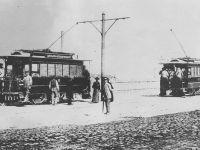 |
We begin with a now classical shot dating back to the first days
of electric traction in Kiev. The line was served by three electric tramcars,
numbers 1 and 2 being shown here. The route sign atop car 2 reads
"Tsarskaya Pl. - Aleksandrovskaya Pl.", and in the background is the
building of the first temporary power station. (Temporary,
because at the time, there was no absolute confidence that the line
was there to stay!)
|
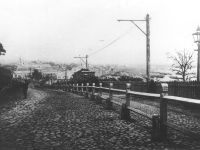 |
This picture from 1894 lets one appreciate how steep indeed the
street was. In the background is Podol, the lower section of town
adjacent to the Dnieper river (the Russian word podol means
'hem'), and the huge domed building to the left
is Tserkov Rozhdestva (Nativity Church) on Pochtovaya Ploschad
(Postal Square).
|
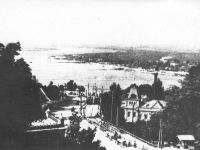 |
Another photo from the same period depicts the line, including the
passing track (the whole route was single-tracked save for
the three of those), against the gorgeous background of the Dnieper's
bend.
|
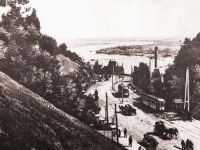 |
Looking from approximately the same point, we see, however, that
the whole line is two-tracked now and is being served by the newer
Pullmann cars. The point in time is therefore somewhere in the
beginning of the 20th century.
(From Mikhail Bulgakov's Kiev, photoalbum, 1990)
|
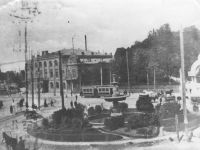 |
Tsarskaya Ploschad was the original upper terminus of the line.
Seen in this photo featuring a Pullmann car is a connection from
the Kreschatik line, to the left, the huge flowerbed in the center,
and the bulding of Merchant Assembly in the background. Only
the latter survives – nowadays, it is home to the Kiev
Philharmonic Society.
|
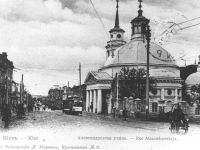 |
The lower, flat part of the track lay on Aleksandrovskaya Street, from Pochtovaya
Ploschad to Kontraktovaya Ploschad. That part was moved to parallel streets
in the beginning of the 1970's due to open cut construction of the metro line
under Aleksandrovskaya, and still survives there, although there is a suggestion
to shut it down. The Nativity Church (no longer existing) is very well visible.
|
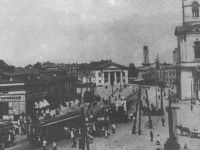
|
The Kontraktovaya Ploschad terminus, in the heart of Podol.
The cityscape has considerably changed here like it has in
the other places, however the building of
Kontraktovyj Dom (Contract House), central in the background,
survives to this day.
|
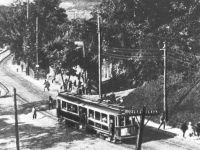 |
The Pullmann mounts the descent some time in the 1930's. Pedestrians
and the tram are still pretty much the only users of the road...
|
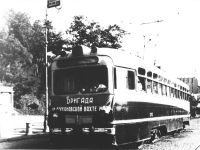 |
The brand new, at the time, MTV-82 car 1285
in Ploschad Stalina (Stalin Square;
yet another name for Tsar Square), could not get more Soviet with
the slogan "The Crew on a Stakhanov Peace Watch" (try to figure out what
those words signify, if you can; to help you, Stakhanov was a miner who once
overfulfilled the coal production plan by some double-digit factor).
Be that as it may, it is serving
route 21, Podol-bound and ready to begin its way down the descent.
|
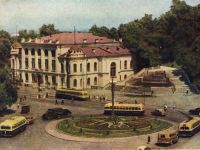 |
Same place, about the same time, – and note the abundance
of MTB-82 trolleybuses,
closely resembling the MTV-82 by shape and livery. The trolleybuses
superseded the trams on Kreschatik in the 1930's, something that
would become standard practice later on... On the place where the steps
are, a park entrance, the monument to Alexander II used to be.
(Photo courtesy of Constantin Antonenko)
|
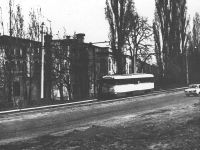 |
Enter the KTV-55-2. This Kiev-manufactured car, sometimes also referred to
as the KTV-57 (and often as a variation of the MTV-82, which it did
resemble, but bore no formal relationship to), was double-ended and became
the only kind serving the line in the 1960's when it was cut back to
its original upper terminus. The route is 16, sharing the street
with a lone Moskvich 412.
|
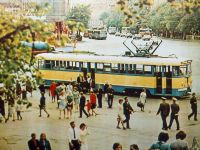 |
This is Ploschad Leninskogo Komsomola (Lenin Young Communist League Square).
You guessed it, right? Former Tsar Square. Former (and today's)
Eur¤pean Square, former Stalin Square, and, while we are at it, former
Horse Square, Ivan Square, III International Square. Note the trolleybuses
(Skoda 9Tr's) in all imaginable liveries swarming Kreschatik in the background.
All gone. Together with the trolley wire.
(Photo courtesy of Alexander Shanin)
|
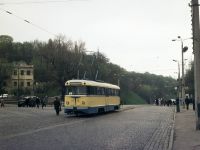 |
KTV-55-2 2018 is on the stub track, getting ready to absorb the crowd
waiting for it (the Philharmonic Society building is barely visible on
the right). The building to the left is the former Europe Hotel, later to
be demolished to make room for the Lenin Museum. Visible above the jeep-like
car is the inscription (which, too, no longer exists)
Volodymyrska Girka (Vladimir Hill) at the
entrance to the park by same name.
(Photo by Hans Oerlemans, May 1970,
courtesy of Alexander Shanin)
|
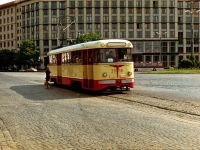 |
The same car in precisely the same spot, from a different vantage point,
with the modern Dnieper Hotel in the background. New colors, though.
Apparently it was decided at some point that the yellow-and-blue livery
bore too much of a resemblance to the traditional Ukrainian banner,
and the politically correct red took the place of blue.
(Photo by Sergey Pirkovsky,
courtesy of Alexander Shanin)
|
This is how it all looks today...
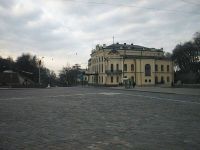 |
European Square. At least the men at power have been wise enough to
give it back its historical name. The Philharmonic Society building
is intact (in fact, it underwent serious renovation not so long ago),
as is the park entrance... and no evidence whatsoever of trams
or trolleybuses that reigned here once upon a time.
(10 March 2002)
|
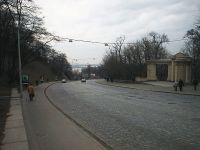 |
The upper part of the descent. Looking carefully, one may notice the
unusually broad sidewalk on the far side – and that's precisely
where the tracks used to be.
(10 March 2002)
|
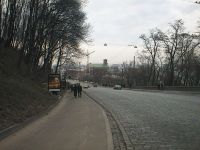 |
The lower part, with Podol in the background. Only because it's a Sunday,
do we see so little traffic here. Come back in the rush hour, and
you are certain to get a good dose of various chemical compounds that trams
did not produce. (Bus number 62 runs the route these days.)
(10 March 2002)
|
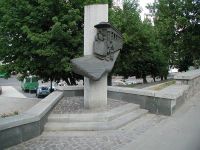 |
In 1992, to celebrate the 100th anniversary of Kiev tram, the monument
commemorating the first tram line was open on Pochtovaya Ploschad.
Needless to say how better would it have been for the tracks and
a vintage tram running on them to be a live monument to themselves...
But this was not to be. So much for the end of the line.
(Photo by Constantin Antonenko)
|

















